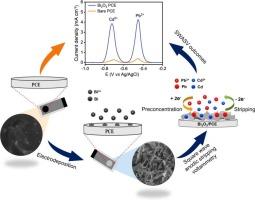基于微型化Bi2O3/塑料芯片电极的电化学传感器对水中Cd2+和Pb2+的高灵敏度和选择性检测
Q1 Environmental Science
Environmental Nanotechnology, Monitoring and Management
Pub Date : 2025-08-15
DOI:10.1016/j.enmm.2025.101095
引用次数: 0
摘要
设计了一种简便、小型化的Bi2O3/塑料芯片电极(PCE),用于Cd2+和Pb2+的同时电化学鉴定。通过恒电位电沉积铋在PCE上进行鉴定,利用扫描电镜(SEM)、x射线衍射(XRD)和x射线光电子能谱(XPS)分别对合成的Bi2O3/PCE进行形貌、晶体结构和元素组成分析。利用循环伏安法(CV)和电化学阻抗谱法(EIS)研究了合成电极的电化学特性。在最佳实验条件下,Bi2O3/PCE在较低pH下对Cd2+和Pb2+表现出显著的电催化性能,与未改性的PCE相比,其方波阳极剥离峰电流增强,对Cd2+和Pb2+的灵敏度分别为12 μA L cm−2 μg−1和20 μA L cm−2 μg−1,对Cd2+和Pb2+的检出限分别为0.09 μg L−1和0.07 μg L−1。该传感器对Cd2+和Pb2+分别具有0.2 ~ 300 μg L−1和0.1 ~ 250 μg L−1的宽线性范围,即使在常见干扰离子存在的情况下也具有良好的选择性。本文章由计算机程序翻译,如有差异,请以英文原文为准。

Highly sensitive and selective detection of Cd2+ and Pb2+ in aqueous system using miniaturized Bi2O3/plastic chip electrode based electrochemical sensor
A facile and miniaturized Bi2O3/plastic chip electrode (PCE) was designed for concurrent electrochemical identification of Cd2+ and Pb2+. The identification was carried out through the potentiostatic electrodeposition of bismuth onto a PCE. The synthesized Bi2O3/PCE was analyzed employing scanning electron microscopy (SEM), X-ray diffraction (XRD), and X-ray photoelectron spectroscopy (XPS) to assess their morphology, crystal structure, and elemental composition, respectively. Cyclic voltammetry (CV) and electrochemical impedance spectroscopy (EIS) were performed to explore electrochemical characteristics of synthesized electrodes. Under optimal experimental conditions, Bi2O3/PCE demonstrated significant electro-catalytic performance for Cd2+ and Pb2+ at lower pH, with augmented square wave-anodic stripping peak currents compared to unmodified PCE. Bi2O3/PCE exhibits an exceptionally high sensitivity of 12 μA L cm−2 μg−1 for Cd2+ and 20 μA L cm−2 μg−1 for Pb2+ with low detection limit of 0.09 μg L−1 for Cd2+ and 0.07 μg L−1 for Pb2+. The developed sensor shows highly reproducible and repeatable performance with an extensive linear range 0.2–––300 μg L−1 for Cd2+ and 0.1–––250 μg L−1 for Pb2+ and also exhibits good selectivity, even when accompanied by common interfering ions.
求助全文
通过发布文献求助,成功后即可免费获取论文全文。
去求助
来源期刊

Environmental Nanotechnology, Monitoring and Management
Environmental Science-Water Science and Technology
CiteScore
13.00
自引率
0.00%
发文量
132
审稿时长
48 days
期刊介绍:
Environmental Nanotechnology, Monitoring and Management is a journal devoted to the publication of peer reviewed original research on environmental nanotechnologies, monitoring studies and management for water, soil , waste and human health samples. Critical review articles, short communications and scientific policy briefs are also welcome. The journal will include all environmental matrices except air. Nanomaterials were suggested as efficient cost-effective and environmental friendly alternative to existing treatment materials, from the standpoints of both resource conservation and environmental remediation. The journal aims to receive papers in the field of nanotechnology covering; Developments of new nanosorbents for: •Groundwater, drinking water and wastewater treatment •Remediation of contaminated sites •Assessment of novel nanotechnologies including sustainability and life cycle implications Monitoring and Management papers should cover the fields of: •Novel analytical methods applied to environmental and health samples •Fate and transport of pollutants in the environment •Case studies covering environmental monitoring and public health •Water and soil prevention and legislation •Industrial and hazardous waste- legislation, characterisation, management practices, minimization, treatment and disposal •Environmental management and remediation
 求助内容:
求助内容: 应助结果提醒方式:
应助结果提醒方式:


